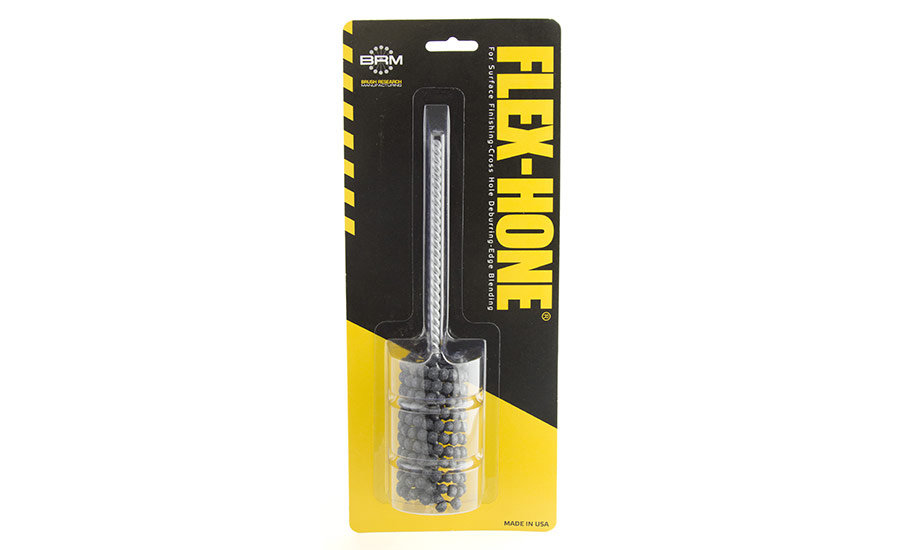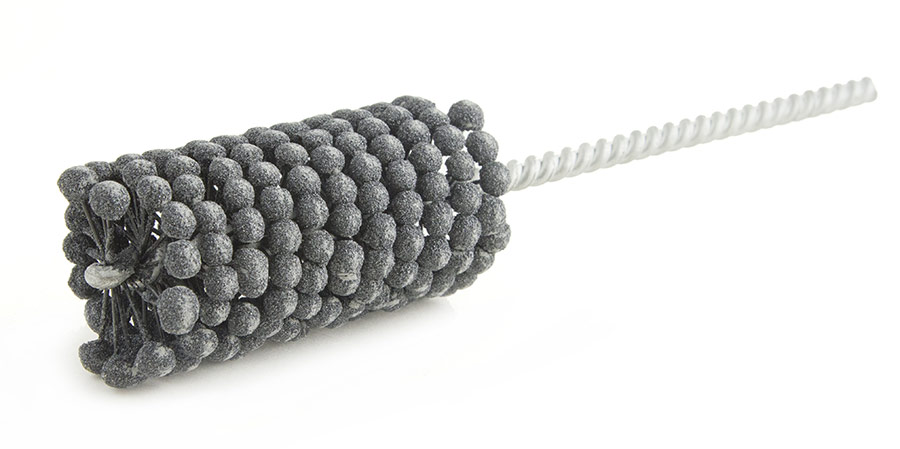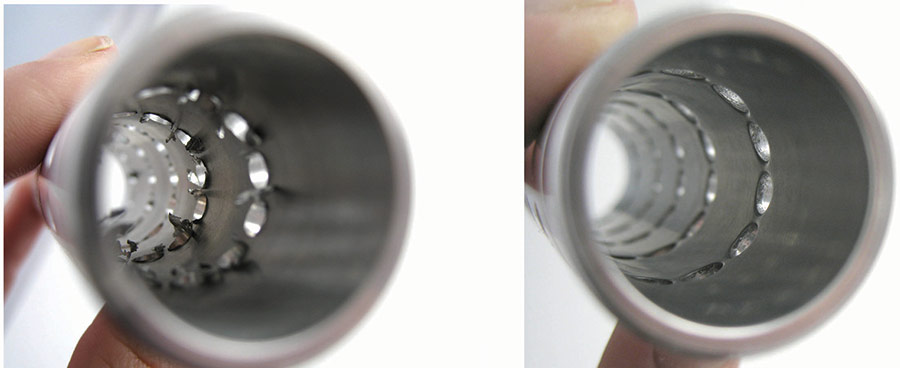Flexible hones effectively deburr complex parts that have cross-drilled holes and difficult-to-access features
September 2018 - Removing burrs and sharp edges from cross-drilled holes, undercuts, grooves, slots and internal holes can be tedious and time consuming. However, when producing high-quality, precision parts, it is necessary to ensure these parts have smooth, round edges.
In many applications, including engine and transmission components, cross-drilled holes act as conduits for fluids, lubricants and gases. Stray burrs can block these critical passages or create turbulence in the flow. They can also lead to part misalignments, affect dimensional tolerances and limit the overall efficiency of machined components.
“Getting rid of burrs is really important because if there is any loose material that gets dislodged when the product is in use, it can cause major problems,” says Anthony Scott, lead machinist at Orange Vise Co., Placentia, California, a manufacturer of machine vises and quick change fixturing components.

Add deburring to production
Many techniques will remove burrs on these internal cross holes, such as thermal, abrasive flow, electrochemical and high-pressure water; however, many of these require sending parts to outside processors or investing in equipment to complete the work in-house. That increases the total time needed for the manufacturing process.
Machining operations can instead choose to integrate deburring into the automated process with a simple, effective cross-hole deburring tool, such as the Flex-Hone from Brush Research Manufacturing Co., Los Angeles. By doing so, operators can speed up the manufacturing process and ensure uniform quality for precision parts.
According to Scott, flexible hones are a cost-effective solution to smooth edges and produce a blended radius for cross-hole deburring. “It is really about accessibility, whether it is internal grooves or multiple cross-holes, there aren’t really any other tools that can do what a Flex-Hone can,” he says.

The Flex-Hone is a highly specialized tool that consists of small, abrasive globules permanently mounted to flexible filaments. These deburring tools are available in sizes ranging from very small diameter hones (4 mm) to 36 in. or even larger diameters (sizes appropriate for cylinder bores).
“I used the Flex-Hone quite a bit when I was working in aerospace,” notes Ken Spaulding of Zodiac Engineering, a contract manufacturer in California. “We did a lot of parts that involved tubes with multiple cross holes and slots. Getting inside there to reach the burrs, particularly if the walls were thick, was extremely difficult.”
With a background in aerospace parts and mold making, Spaulding is focused on designing his own products, such as high-end pocket knives and cycling components for BMX, road and mountain bikes. He also performs contract manufacturing work.
Close-tolerance finish
Spaulding particularly appreciates how the flexible hone’s abrasive globules each have an independent suspension that is self-centering, self-aligning to the bore and self-compensating for wear, all of which facilitate close-tolerance finishing work.
“The hone conforms to whatever you are working with, even if it’s irregular,” he says. “For example, if the back side of the part is not flat or not on a consistent level plane in Z, the tool is still flexible enough to remove any burrs.”

For the best results, the Flex-Hone should be rotated into the main bore where the cross holes break. After a few clockwise strokes, the tool is removed and the spindle reversed to rotate and stroke the flexible hone in a counterclockwise direction for a few more strokes. The forward and reverse rotation creates a symmetrical deburring pattern. Coolant should be used to keep metal cuttings and deburred metal in suspension.
According to Scott, although the Flex-Hone is often used with automated production equipment, it can also be used with a cordless drill for secondary deburring options offline, as needed.
“So, if you manage to deburr 90 percent of the holes in a machine but have a few left you can’t access easily, you can use it with a handheld drill and maintain the uniformity in surface finish and process,” he says.
Brush can customize shapes even further to meet the requirements of non-traditional applications. This includes spherical-end configurations, stepped or multi-diameter configurations for double diameters and counter-bores, tapered or cone shapes, segmented shapes, or combining Flex-Hone globules with other filament materials.
Brush Research Manufacturing Co. Inc.
Los Angeles
323/361-2193
Orange Vise Co.
Placentia, California
714/482-3952
Zodiac Engineering
Orange, California

